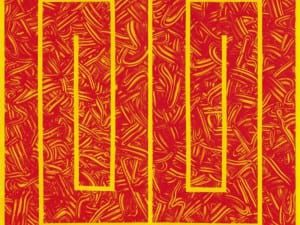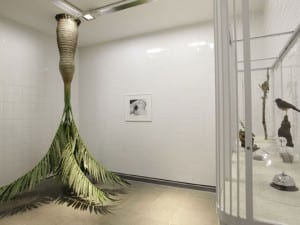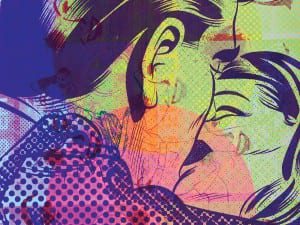Review by Paul Hardman
The most important thing to say about this George Shaw exhibition, The Sly and Unseen Day is that the paintings are incredible. Of course the subject matter is what would be considered ugly, or at best mundane, but since his images tend to look rather downbeat and dry in reproductions it should be emphasised that seeing the actual paintings is an unexpectedly rich experience.
Shaw has recently become much more high profile due to his nomination for the Turner Prize, and his selection is unusual in that he is a figurative painter, and so, superficially at least, he is not a challenging or radical artist of the type that the Turner Prize usually seems to promote. However, Shaw’s work is constrained by two key restrictions, adding a conceptual element that strengthens the integrity of the work. First, his paintings exclusively depict the landscape of a half-mile radius around his childhood home on the Tile Hill estate in Coventry, second, he paints only in Humbrol enamel, the type of paint used by hobbyists to paint model aeroplanes. This choice of medium aligns his work both to childhood or adolescence, and away from the history of fine painting.
The results are not childish or naive, but mature and impressive. The slick nature of the paint creates a sleek smooth surface, closer to the surface of a photograph than to an oil painting. No trace of the texture of the board can be perceived. On close inspection the trace of the brush can be seen in the shape of the marks, but not through any disturbance of the surface. Shaw has achieved a unique light in these images, the pictures are both dull, dim and muted, while glowing with a suppressed light that perfectly depicts the sunlight behind clouds, the period of increased brightness after rain that is not yet a clear sky, which is a defining characteristic of this country. His skies take on a particularly uncanny sheen, rendered in this medium, when overcast they are like vast sheets of something leaden and seamless, when they are post-sunset skies they take on the glow of sheets of copper or zinc.
The presentation of the exhibition is extremely simple, the pictures are evenly spaced around the walls of the large central room of the gallery, subtly sequenced and grouped so that one composition may follow the previous image. For instance the central motif of a grid of window and door frames of what could be the side of a school or other council building in Poets Day (2005-6) is echoed in the adjacent painting, The Back that used to be the Front (2008), a painting of would seems to be a boarded up show unit. Both are in a direct front on composition that recalls the lines and rectangles of Piet Mondrian, except here we are shown not abstract constructions, but the scratched, neglected and graffiti covered surfaces of run down council estate buildings.
Elsewhere paintings are linked by other formal elements, a view of a mutely coloured estate with a post box in the centre of the frame, followed by the back of a spiked metal fence with a red phone box in the centre of the frame (this image has the title Time Machine, Shaw is happy to share his dry humour now and again). The following image again includes a similar fence. This repetition has been highlighted by the curators, but was clearly considered by Shaw as he went about his meticulous task. In fact Shaw has considered his selection of subjects extremely carefully. It is a delicate balance, as his places both seem to be inconsequential: they look as though they could be anywhere, as if they have been selected by some arbitrary method, in the way that say, the Boyle Family would randomly select nowhere places to reproduce. But each of Shaw’s paintings are well considered, and the places are really quite specific, they are known to him intimately as the stomping grounds of his childhood.
The notion of returning to childhood or adolescence is perhaps a cliché, but never has the return been so rigorous, so dispassionate, and so sublime.
George Shaw The Sly and Unseen Day continues at South London Gallery until 3 July.
southlondongallery.org
Aesthetica Magazine
We hope you enjoying reading the Aesthetica Blog, if you want to explore more of the best in contemporary arts and culture you should read us in print too. In the spirit of celebration, Issue 41 includes a piece on Guggenheimn Bilbao where the Luminous Interval features internationally acclaimed artists such as Louise Bourgeois, Kiki Smith and Damien Hirst, ArtAngel’s new commission at MIF, Bruce Nauman’s retrospective at The Kunsthalle Mannheim and Cory Arcangel’s Pro Tools at the Whitney in NYC. You can buy it today by calling +44(0)1904 479 168. Even better, subscribe to Aesthetica and save 20%. Go on, enjoy!
Image:
George Shaw, No Returns (2009)
Copyright the artist, courtesy Wilkinson Gallery, London





